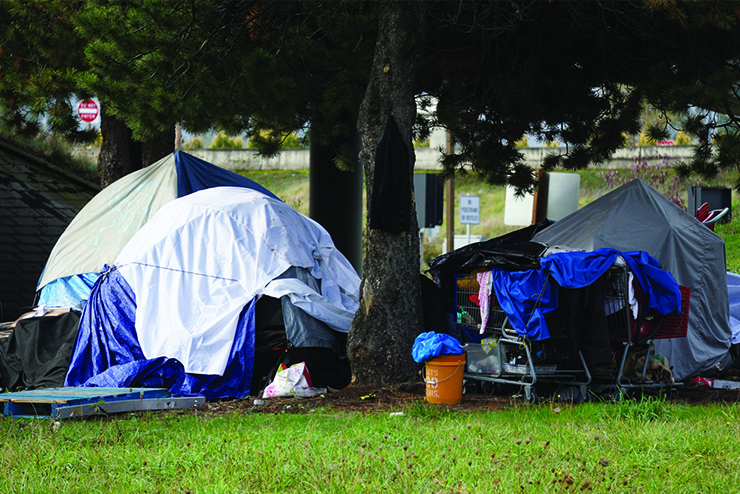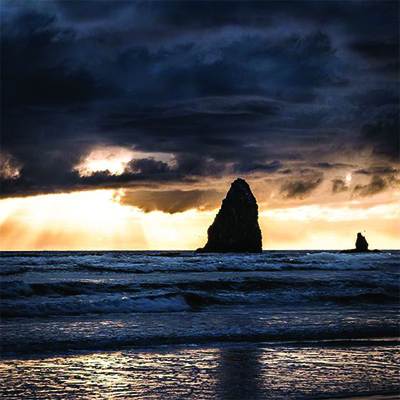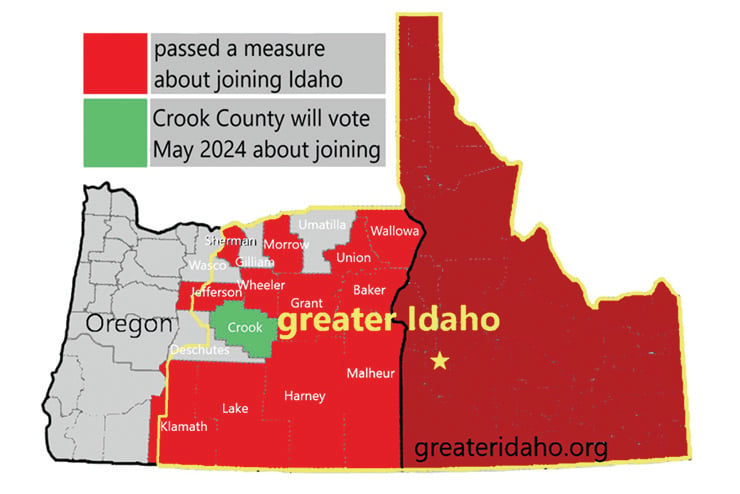Oregon’s blue cities and red countryside are so polarized that citizens of the latter have passed several measures to secede to “Greater Idaho.”
Interesting place, Oregon. I know; you take most 98,000-square mile entities, and you’re apt to find a bit of variety in the mix. But in the case of the so-called Beaver State it’s almost like a form of schizophrenia. The region is as wildly contradictory in its way as was the old pre-World War I Balkans, a seemingly placid, largely rural outpost where ethnic and tribal rivalries seethe furiously just below the surface.
In Oregon, the essential rift is between two cultures. One is epitomized by a state legislature and its vast bureaucratic apparatus busily turning out ever more initiatives on widows, orphans, the racially oppressed, the poor, the maimed, the halt and the blind. The other is characterized by the spirit of rugged individualism responsible for having settled the American West in the first place.
In the first context, there’s the once-bustling riverside city of Portland. Roughly 2 million people live in its metro area, which is half the population of Oregon as a whole. Though not without a certain residual hippie charm, with its profusion of bicycles and artisanal coffee bars, Portland’s core business area, or what remains of it, increasingly resembles the Dunkirk of May 1940. Standing atop downtown Moda Tower at night is like surveying the aftermath of a battlefield, with several hundred homeless residents looking like the remnants of a defeated army, hunched together around braziers or lying on cots displayed in rows on the sidewalk.
Evidently no one in Portland bothers about enforcing the few remaining laws involving public drug use or befouling the streets. The much shrunken, demoralized police bureau, its budget slashed in the wake of the George Floyd riots of 2020, in October had a total of 803 sworn members, of whom just 297 are active patrol officers, according to data on the city’s website. This is the force’s lowest strength since 1980, and the city’s population has grown 75 percent since then, adding 269,000 new residents.

these are a few of many tents that line the I-5 corridor and elsewhere in and around the city
(Wanda Jewell / Getty Images)
Just outside this toxic bubble there’s the “real” Oregon. Picture a vast, bucolic land tucked away between the Pacific Ocean on one side and immense forests of Douglas fir trees on the other. Picture also a shoreline of unspoiled sandy beaches, under cloud-mottled skies and a distant sweep of snow-capped mountains with names like Middle Sister or Three Fingered Jack. Finally, picture a scene that epitomizes a certain kind of traditional Far West life, untouched by whatever social pathologies currently obsess its big-city neighbors. What you have pictured is mainstream Oregon.
Should you be lucky enough to leave the narrow corridor formed by Portland, the state capital Salem, and the nearby college towns of Corvalis and Eugene, and drive west to the Oregon coast, as I did the other day, you seem to pass from a mad world into a sane one. Behind you is the moronic urban inferno and its pervasive air of permanent existential crisis; ahead lies a chain of bucolic hamlets populated by friendly, well-dressed men and women who are in essence unchanged from the time when Ike was in the White House and Dean Martin sang “That’s Amore” on the radio. You see long rows of neat, clapboard houses, many with a U.S. flag fluttering out front, and spruce little towns with names like Rockaway Beach, Seaside, Tillamook, and Wheeler.
There’s a certain added poignancy to the last of these names. A century ago, the place in question was a logging boomtown, and the big man locally was a sawmill operator and philanthropist called Coleman Wheeler, who eventually gave it his name. Coleman’s great-grandson is none other than “Tear Gas Ted” Wheeler, the mayor of Portland since 2016, who at one time was fond of standing on his city’s courthouse steps to express solidarity with the George Floyd-inspired rioters, when not residing at one of his two out-of-town family homes. (The Wheelers’ timber business was sold in 2002 to the Weyerhaeuser Company for $6 billion, a reported $90 million of which went to the family; Ted Wheeler declared an average annual income of about $1.5 million at the time he became mayor.)
To get a snapshot of the political Grand Canyon that runs through Oregon today, you need only look at the results of the November 2020 general election. In metropolitan Multnomah county, which includes Portland, Joe Biden won 79.8 percent of the vote. About 250 miles southeast in Grant county, where they used to profitably pan for gold until the federal government outlawed it in 1942, 77.5 percent opted for Donald Trump. Aside from being part of the same consolidated territory admitted to the Union in 1859, these two enclaves would seem to have little, if anything, in common.
Meanwhile, in the 2022 midterms Oregon voters elected as governor one Tina Kotek, an apparently “proudly lesbian” Democrat, by a relatively narrow 47 to 43.6 percent margin over her Republican opponent Christine Drazan, a state legislator who among other things opposed both COVID-19 vaccination mandates and the notion that sex-change athletes might participate in gender-specific sporting events.
Again, there was a striking regional disparity between the two candidates’ support. In Multnomah county, they went for Kotek by 72.7 percent, giving just 19.7 percent to her GOP challenger. That was the mirror opposite of rural Morrow county, which voted 73.9 percent in favor of Drazan. The figures were even more striking in aptly named Lake County, one of the loveliest in the state, whose voters opted for the Republican candidate by the small matter of 82.5 percent and gave just 10.8 percent to her rival.
All this is by way of a backdrop to the pioneering decision of the voters of two Oregon counties in November 2020 to secede from their state and join Greater Idaho instead. They were followed by the similarly inclined voters of five more counties in the May 2021 election, and a further five in May 2023.
At this stage, the secession resolutions passed since 2021 require only that the areas’ elected commissioners meet and discuss the proposal. The odds are still against anyone significantly redrawing the map of the Pacific Northwest anytime soon. But it may be that the disaffected farmers and loggers of south and eastern Oregon have irresistible logic on their side when they complain about their treatment at the hands of the big-city slickers in Portland and elsewhere. The latter have recently been busy drafting laws that make it illegal in Oregon workplaces to so much as comment on an individual’s choice of hairstyle or clothing. They’ve also pioneered the distribution of a “wellbeing” survey to the state’s sixth-grade schoolchildren asking them to define their sexuality by choosing from a list of 12 options, to give just two of the many available examples.
Perhaps it’s no wonder that Mike McCarter, the president of what’s become known as the Greater Idaho Movement, feels the momentum for change. Recent events at the ballot box “prove that rural Oregon wants out,” he announced. “If the legislature really believes in liberal values such as self-determination, [it] won’t hold our counties captive against our will.” Even Governor Kotek was recently moved to remark, “I think there are a lot of Oregonians who are frustrated and don’t feel heard”, before going on to pour a politician’s balm on the issue. “We have things that we will solve together, and I’m hoping through dialogue and conversation that we can address concerns and move forward as one state.”
No one pretends that there will be a significant realignment of Oregon’s border with Idaho in the immediate future, nor that the road ahead is a straightforward one. As of late 2023, a dozen relatively sparsely populated Oregon counties have approved a variety of ballot measures in favor of exploring their territorial options. Voters in the state’s remaining 24 counties have yet to decide on the matter. McCarter and his colleagues know that the area around greater Portland and the “political nuthouse” of Salem, as inscrutable and despotic in its way as any Oriental sultanate, would never countenance it. The Greater Idaho planners understand their limitations. Their current proposal is to secure a mandate in a total of 15 counties, representing around 385,000 Oregonians. That would embrace 64 percent of the state’s land mass, but just 9 percent of its population.
Even if ultimately approved by a majority of Oregon voters, any plan to redraw the state’s border with its eastern neighbor would require approval both by the Salem legislature and the U.S. Congress. This latter provision might be the most significant hurdle of all. Just for reference, the last detectable change to the nation’s interstate map occurred in August 1961, when Minnesota agreed to cede two narrow strips of lightly populated marshland to North Dakota. Even that modest initiative came about only as the result of prudent geological housekeeping—the land in question had changed shape due to the action of the Red River—rather than any populist ballot measure.
Similarly, the 1970 Boundary Treaty between the United States and Mexico resolved certain irregularities caused by the shifting banks of the Rio Grande. A 450-acre parcel of land known as the Horcon Tract was transferred south as a result,
although it somehow fails to come as a surprise to learn that almost all the thousand or so residents of the area took the opportunity to relocate to the northern side of the redrawn border.

So it’s a slow, patient, but incremental process that lies ahead for the backers of the Greater Idaho movement. The next potential piece in the jigsaw is central Oregon’s Crook county, whose 20,000 voters will be asked next spring whether they, too, wish to join the initiative. This is the same county that went for Trump over Biden by a 73.5 to 24.7 percent majority in the last presidential election.
To get a sense of possible future developments, I spoke to another of the Greater Idaho leaders, Matt McCaw, who himself lives in Crook county.
“The big challenge right now is to get the two state legislatures talking,” he told me.
They’ve already passed a resolution in the Idaho House, although it’s stalled in the Senate. Not surprisingly, no one in Salem is interested. Our main priority going forward is to try and educate people on both sides of the east-west divide in Oregon about why [secession] would be a good deal for all parties, and continue to work with the legislature to push forward talks with Idaho. The urban/rural divide in Oregon isn’t going away. Moving the border would be a long-term solution for people on both sides of the state.
“Of course,” McCaw continued, “there’s a certain kind of person who never wants to lose authority over anything.” (Surely this is one of the observable lessons of the whole COVID-19 ordeal). “There another kind who simply can’t or won’t imagine the type of fundamental change a redrawn state map would involve. It’s just beyond their comfort zone,” he said.
“On the other hand,” McCaw concluded,
Look at how much we’ve all readjusted to things like gay marriage or legalized marijuana just over the last 20 years or so—issues our parents’ generation would have thought hardly possible. If we can accept major changes to society like that, I’m pretty sure we’ll eventually be able to get our heads around the concept of adjusting the state map to reflect the clear will of the people. That shouldn’t be so hard, should it? It may take a while, but I truly believe our time is coming.

Leave a Reply